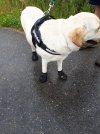Uncontrolled animal is one that is not under the control of its handler and acts exclusively at his own free will.
And while I agree with having your dog under control, it seems to me that 500kg animal that can easily trample you to death should also be under some kind of control. So it is not sole fault of the dog owner.
I did not talk about fault. I described what is known about the recent incident mentioned earlier in this thread.
I described what ought to be common knowledge for any dog owner who walks his or her dog in rural areas where cattle feeds on grassland.
In the Alpine regions in Germany, Austria and Switzerland where there have been a number of attacks by cows over the last two decades (perhaps a result of more people walking for leisure on their holidays
and taking their dogs with them), some of them fatal and all of them involving tourists or locals walking their dog near an area where milk cows with calves are feeding, there have been not only such attacks but also court cases and, in the case of Austria at least, a change of law to clarify penal law and civil law responsibilities. There have also been efforts by the civil society to establish a catalogue of rules for the behaviour of dog owners so that tourists and others who walk with their dogs in such areas are better informed.
I did not check to what extent such rules have been established in Spain or are widely known in Spain.
BTW, I never walked where the incident with the two injured pilgrims happened but I walked in Galicia. As probably everyone knows who has ever walked on a Camino in Galicia, cow herds are being driven along the public road and that's the same public road where pilgrims walk. In the case of the injured pilgrims near Salamanca, it says that the herd was moved
between farmland on both sides of the Cañada Real. A Cañada Real is a traditional path for moving lifestock in Spain. This particular cañada happens to be used by the Via de la Plata Camino trail, too. There are no fences
on a trail that is used by animals guided by their farmer to get from A to B and back again.




















